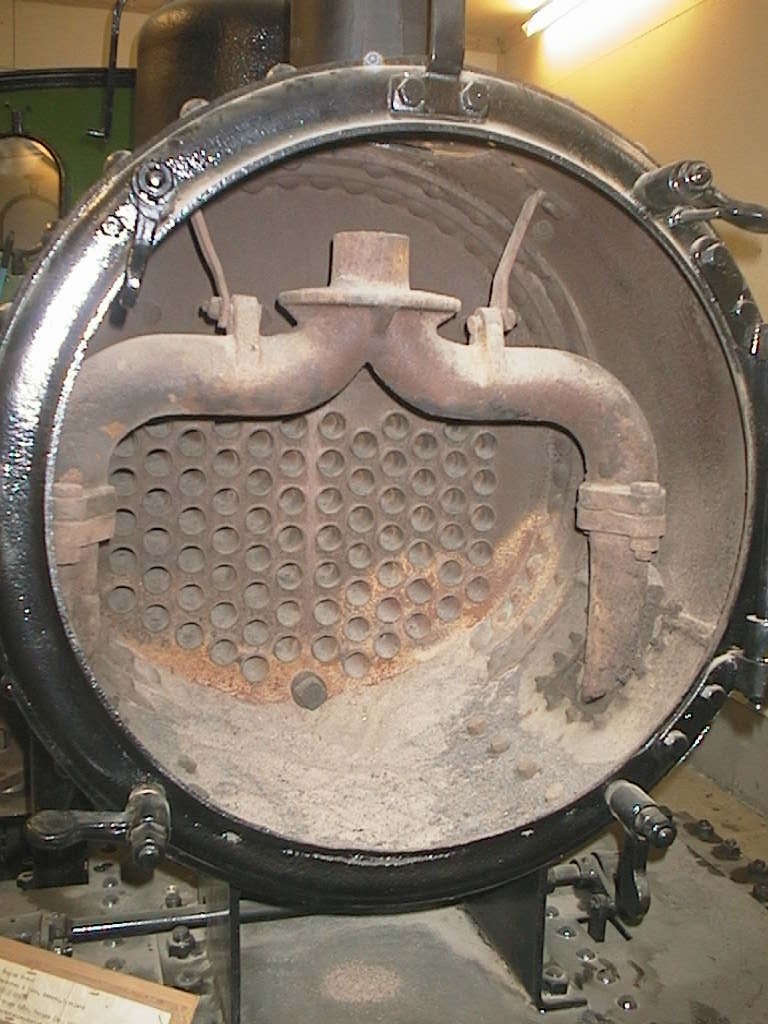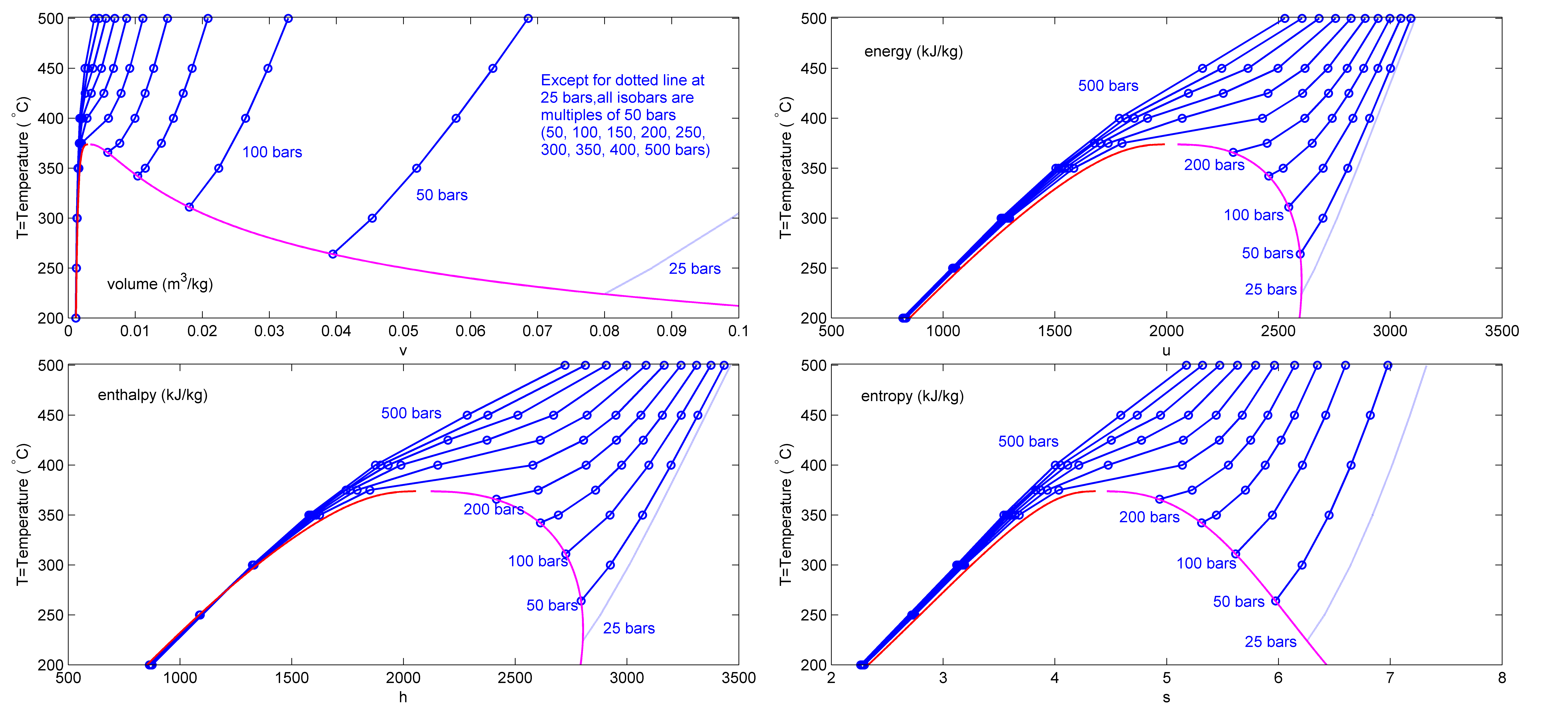|
Superheater
A superheater is a device used to convert saturated steam or wet steam into superheated steam or dry steam. Superheated steam is used in steam turbines for electricity generation, in some steam engines, and in processes such as steam reforming. There are three types of superheaters: radiant, convection, and separately fired. A superheater can vary in size from a few tens of feet to several hundred feet (a few metres to some hundred metres). Types * A radiant superheater is placed directly in the radiant zone of the combustion chamber near the water wall so as to absorb heat by radiation. * A convection superheater is located in the convective zone of the furnace, in the path of the hot flue gases, usually ahead of an economizer. A convection superheater is also called a primary superheater. * A separately fired superheater is a superheater that is placed outside the main boiler and has its own separate combustion system. This superheater design incorporates additional burners i ... [...More Info...] [...Related Items...] OR: [Wikipedia] [Google] [Baidu] |
Snifting Valve
A snifting valve (sometimes snifter valve) is an automatic anti-vacuum valve used in a steam locomotive when coasting. The word ''Snift'' imitates the sound made by the valve. Overview When the driver shuts off the steam to the cylinders of a steam locomotive while it is in motion, the moving pistons could create a partial vacuum in the cylinders. This would give rise to two problems. Firstly, the pumping action would absorb energy and prevent the engine from coasting freely. Secondly, when the exhaust valve opened, soot and cinders from the smokebox could be sucked down the exhaust pipe and into the valve chest or cylinder, causing damage. (The exhaust is open to the smokebox because in normal running the exhaust steam is sent through the blastpipe to draw the fire and eject the combustion products from the chimney.) These problems are avoided by using snifting valves to allow air to be drawn into the cylinder. On railways which did not use snifting valves, drivers were instr ... [...More Info...] [...Related Items...] OR: [Wikipedia] [Google] [Baidu] |
Boiler
A boiler is a closed vessel in which fluid (generally water) is heated. The fluid does not necessarily boil. The heated or vaporized fluid exits the boiler for use in various processes or heating applications, including water heating, central heating, boiler-based power generation, cooking, and sanitation. Heat sources In a fossil fuel power plant using a steam cycle for power generation, the primary heat source will be combustion of coal, oil, or natural gas. In some cases byproduct fuel such as the carbon monoxide rich offgasses of a coke battery can be burned to heat a boiler; biofuels such as bagasse, where economically available, can also be used. In a nuclear power plant, boilers called steam generators are heated by the heat produced by nuclear fission. Where a large volume of hot gas is available from some process, a heat recovery steam generator or recovery boiler can use the heat to produce steam, with little or no extra fuel consumed; such a configuration is ... [...More Info...] [...Related Items...] OR: [Wikipedia] [Google] [Baidu] |
Smokebox
A smokebox is one of the major basic parts of a steam locomotive exhaust system. Smoke and hot gases pass from the firebox through tubes where they pass heat to the surrounding water in the boiler. The smoke then enters the smokebox, and is exhausted to the atmosphere through the chimney (or funnel). Early locomotives had no smokebox and relied on a long chimney to provide natural draught for the fire but smokeboxes were soon included in the design for two specific reasons. Firstly and most importantly, the blast of exhaust steam from the cylinders, when directed upwards through an airtight smokebox with an appropriate design of exhaust nozzle, effectively draws hot gases through the boiler tubes and flues and, consequently, fresh combustion air into the firebox. Secondly, the smokebox provides a convenient collection point for ash and cinders ("char") drawn through the boiler tubes, which can be easily cleaned out at the end of a working day. Without a smokebox, all char m ... [...More Info...] [...Related Items...] OR: [Wikipedia] [Google] [Baidu] |
Superheated Steam
Superheated steam is steam at a temperature higher than its vaporization point at the absolute pressure where the temperature is measured. Superheated steam can therefore cool (lose internal energy) by some amount, resulting in a lowering of its temperature without changing state (i.e., condensing) from a gas to a mixture of saturated vapor and liquid. If unsaturated steam (a mixture which contains both water vapor and liquid water droplets) is heated at constant pressure, its temperature will also remain constant as the vapor quality (think dryness, or percent saturated vapor) increases towards 100%, and becomes dry (i.e., no saturated liquid) saturated steam. Continued heat input will then "super" heat the dry saturated steam. This will occur if saturated steam contacts a surface with a higher temperature. Superheated steam and liquid water cannot coexist under thermodynamic equilibrium, as any additional heat simply evaporates more water and the steam will become saturate ... [...More Info...] [...Related Items...] OR: [Wikipedia] [Google] [Baidu] |
Steam Locomotive
A steam locomotive is a locomotive that provides the force to move itself and other vehicles by means of the expansion of steam. It is fuelled by burning combustible material (usually coal, Fuel oil, oil or, rarely, Wood fuel, wood) to heat water in the locomotive's Boiler (power generation), boiler to the point where it becomes gaseous and its volume increases 1,700 times. Functionally, it is a steam engine on wheels. In most locomotives, the steam is admitted alternately to each end of its Steam locomotive components, cylinders in which pistons are mechanically connected to the locomotive's main wheels. Fuel and water supplies are usually carried with the locomotive, either on the locomotive itself or in a Tender (rail), tender coupled to it. #Variations, Variations in this general design include electrically powered boilers, turbines in place of pistons, and using steam generated externally. Steam locomotives were first developed in the United Kingdom of Great Britain an ... [...More Info...] [...Related Items...] OR: [Wikipedia] [Google] [Baidu] |
LB&SCR I3 Class
The LB&SCR I3 class was a class of 4-4-2 steam Steam is water vapor, often mixed with air or an aerosol of liquid water droplets. This may occur due to evaporation or due to boiling, where heat is applied until water reaches the enthalpy of vaporization. Saturated or superheated steam is inv ... tank locomotives designed by D. E. Marsh for suburban passenger service on the London, Brighton and South Coast Railway. History After introducing two unsuccessful designs of 4-4-2 tank locomotive with the LB&SCR I1 class, I1 and LB&SCR I2 class, I2 classes, D. E. Marsh, Douglas Earle Marsh learned a lesson and provided a new design with a far larger firebox. The new design was a tank version of R. J. Billinton, Robert Billinton's successful LB&SCR B4 class, B4 class tender locomotives. At the time of its introduction locomotive engineers were beginning to take an interest in superheater, superheating and Marsh therefore ordered two locomotives from Brighton railway works for compa ... [...More Info...] [...Related Items...] OR: [Wikipedia] [Google] [Baidu] |
Prussian S 4
The Prussian S 4's were German superheated express steam locomotives with the Prussian state railways, later grouped as DRG Class 13.5 in the Deutsche Reichsbahn. They were an evolutionary development of the Prussian S 3. The first locomotive was built in 1898 by Vulcan, Stettin as a modified S 3. She was the first superheated locomotive in the world.Rauter and Scheingraber (1991), pp. 84-90. She was initially designated as ''Hannover 74'' and towards the end as the S 4 ''Cassel 401''. Two further trials locomotives appeared in 1899 and 1900 as ''Hannover 86'' and ''Berlin 74'' also classed as S 3's. They were later reclassified as S 4's ''Hannover 401'' and ''Posen 401''. Not until the teething troubles had been resolved was the S 4 put into series production in 1902 in Borsig, from 1906 also in Henschel and Humboldt. Unlike the prototypes the production engines were developed independently of the S 3, and 104 examples were built in the years to 1909 when procurement was halted ... [...More Info...] [...Related Items...] OR: [Wikipedia] [Google] [Baidu] |
Wilhelm Schmidt (engineer)
Wilhelm Schmidt, known as Hot Steam Schmidt (German: ''Heißdampf-Schmidt'') (1858–1924) was a German engineer and inventor who achieved the breakthrough in the development of superheated steam technology for steam engines. Wilhelm Schmidt was born in Wegeleben in the Prussian Province of Saxony on 18 February 1858. Education At school Wilhelm Schmidt had difficulties with reading, writing and arithmetic, a case of dyslexia. For example, he was unable to recite the alphabet without hesitation all his life. Nor could he memorise poetry or prose. He developed a passion for drawing, however, and for machines. Career Schmidt began his professional career as a machine fitter. He studied at the technical high school in Dresden under Gustav Zeuner. Superheated steam In 1883 he took a post as a civil engineer in Kassel, where he developed superheated steam technology to the point where it could be practically used. In 1908 he transferred his home and the base of his firm to B ... [...More Info...] [...Related Items...] OR: [Wikipedia] [Google] [Baidu] |
Steam Engine
A steam engine is a heat engine that performs Work (physics), mechanical work using steam as its working fluid. The steam engine uses the force produced by steam pressure to push a piston back and forth inside a Cylinder (locomotive), cylinder. This pushing force can be transformed by a connecting rod and Crank (mechanism), crank into rotational force for work. The term "steam engine" is most commonly applied to reciprocating engines as just described, although some authorities have also referred to the steam turbine and devices such as Hero's aeolipile as "steam engines". The essential feature of steam engines is that they are external combustion engines, where the working fluid is separated from the combustion products. The ideal thermodynamic cycle used to analyze this process is called the Rankine cycle. In general usage, the term ''steam engine'' can refer to either complete steam plants (including Boiler (power generation), boilers etc.), such as railway steam locomot ... [...More Info...] [...Related Items...] OR: [Wikipedia] [Google] [Baidu] |
Economizer
Economizers (US and Oxford spelling), or economisers (UK), are mechanical devices intended to reduce energy consumption, or to perform useful function such as preheating a fluid. The term economizer is used for other purposes as well. Boiler, power plant, heating, refrigeration, ventilating, and air conditioning (HVAC) may all use economizers. In simple terms, an economizer is a heat exchanger. Stirling engine Robert Stirling's innovative contribution to the design of hot air engines of 1816 was what he called the 'Economiser'. Later known as the regenerator, it stored heat from the hot portion of the engine as the air passed to the cold side, and released heat to the cooled air as it returned to the hot side. This innovation improved the efficiency of the Stirling engine enough to make it commercially successful in particular applications, and has since been a component of every air engine that is called a Stirling engine. Boilers In boilers, economizers are heat exchange de ... [...More Info...] [...Related Items...] OR: [Wikipedia] [Google] [Baidu] |




